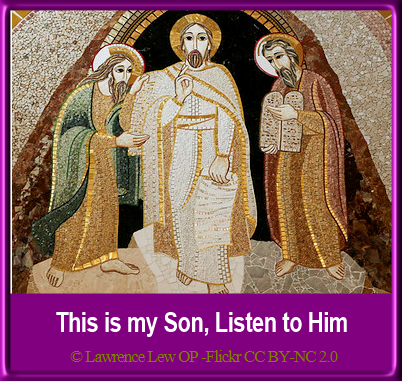13 March 2022
Genesis 15:5-12, 17-18 Philippians 3:17-4:1 Luke 9:28-36
The Transfiguration of Jesus
The transfiguration of Jesus has captured the imagination of artists down through the ages. Among the many mosaics, paintings and icons depicting this scene, the sixth century mosaic in the Basilica of the monastery of St Catherine in Sinai is my favourite. It dates from the 6th century AD. At the centre of the mosaic is the figure of Jesus transfigured. His right hand is raised in blessing and his eyes directed towards us. His clothes are shining white with gold edging. From His body, shafts of light emanate towards each of the five figures present: to the right of Jesus, the prophet Elijah; to his left Moses; around his feet, the Apostles John, Peter, and James. This wonderful mosaic captures the drama of the event: the three Apostles in a state of shock and bewilderment, while Jesus stands serenely above them, flanked by Moses and Elijah, who appear to be blessing him.
The story of the Transfiguration, as recounted by Luke in today’s gospel, takes place at a critical moment in Jesus’ ministry. He would soon leave behind beautiful Galilee and ‘turn his face resolutely towards Jerusalem’ (Lk 9:51), where he sensed that he would suffer the same fate as the prophets before him. As he had forewarned his disciples: ‘The Son of man is destined to suffer grievously, to be rejected by the elders and chief priests and scribes, to be put to death, and to be raised up on the third day’ (Lk 9: 22). He reminded them that they, too, if they wished to be his disciples, must share his cross and be prepared to lose their lives for his sake (cf. Lk 9:23-24).
In moments of crisis, or when facing a major decision, it was Jesus’ custom to withdraw to a lonely place and spend time, sometimes all night, communing with his Father in prayer (cf. Lk 6:12-13). On this occasion Jesus takes with him three of his disciples, Peter, James and John, and goes up a mountain (probably Mount Tabor) to pray, and as he prays, he is transfigured. In the words of Luke, ‘the aspect of his face was changed and his clothing became sparkling white’ (Lk 9:29). Luke highlights the significance of the transfiguration for Jesus himself and for his beloved disciples. As on the occasion of his baptism by John, in this moment of luminosity, a voice from heaven confirms the identity and messianic vocation of Jesus. ‘And a voice came from the cloud saying, This is my Son, the Chosen One Listen to him’ (Lk 9:35). This affirmation strengthened Jesus to face into the dark and threatening future that lay ahead as he resolutely took the road to Jerusalem. For Luke, the glorious manifestation of Jesus is inseparable from the shadow of the Cross. He tells us that the conversation between Jesus, Moses and Elijah on the Mountain was about ‘his passing which he was to accomplish in Jerusalem’ (Lk 9:31).
The transfiguration experience was important not just for Jesus but even more so for his beloved disciples, Peter, James, and John. Their eyes are opened to catch a glimpse of Jesus in his glory and their ears are opened to hear the divine confirmation of Jesus’ identity as ‘beloved Son’ to whom they are called to listen. Captivated by the experience, Peter wants to remain on the mountain in the exalted company of Elijah, Moses and Jesus. However, this is not to be. The moment of illumination passes and the three disciples find themselves alone with Jesus.
Lent is a time to remember such moments in our own lives and draw strength from them. It is a time to trust in the Lord like Abraham in our first reading: ‘Abraham put his faith in the Lord, who counted this as making him justified’ (Gen 15:6). It is a time to withdraw to the mountain with Jesus, to listen to him, and let him lead us on our journey towards Easter, mindful, as our second reading tells us that Jesus ‘will transfigure these wretched bodies of ours into copies of his glorious body’ (Phil 3:21). In these frightening and uncertain times, we need a light that lights up the mystery of life in depth and helps us to move beyond the struggles, the doubts and fears of our everyday lives. Like Peter, James and John, we too are invited to climb up the mountain and contemplate the beauty of Christ transfigured, casting glimmers of light in every fragment of life and helping us to interpret history in the light of Easter.
However, like the beloved disciples of Jesus, we cannot remain on the mountain. Jesus himself brings us back to the valley, among our brothers and sisters and into daily life. In the words of Pope Francis, ‘Going up the mountain does not mean forgetting reality. Praying never means avoiding the difficulties of life. The light of faith is not meant just to provide beautiful spiritual feelings. This is not Jesus’ message. We are called to experience the encounter with Christ so that, enlightened by his light, we might take it and make it shine everywhere’. We must bring the light of Christ to others. So let us, in the words of the American poet, Amanda Gorman,
‘….step out of the shade, aflame and unafraid.
The new dawn blooms as we free it.
For there is always light,
if only we’re brave enough to see it.
If only we’re brave enough to be it.’
Michael McCabe SMA, March 2022
To listen to an alternative Homily from Fr Tom Casey of the SMA Media Centre, Ndola, Zambia please click on the play button below.
|
|

